WASHINGTON – A new website and smartphone app, on which a group of Maryland-area recreational anglers worked for months, is expected to enhance the quality of a federally run program that tracks and helps manage recreational fisheries.
Based on a similar one first developed in Florida, the app may also help build trust between the recreational angler community and the agencies that manage the fisheries.
According to the Maryland Department of Natural Resources, Chesapeake Catch, launched in November, will be used to monitor Atlantic croaker, red drum, spotted sea trout, shad, spot fish, striped bass and yellow perch.
“The MD Fisheries Service (a division of the Department of Natural Resources) worked with the Chesapeake Catch team for over a year to develop this phone app with useful features for both recreational anglers and fisheries managers,” said Linda Barker, chief research statistician for the DNR Fisheries Service, in an email.
For years, states have monitored recreational fisheries with a set of surveys designed by the fishery division of the National Oceanic and Atmospheric Administration. But those statistical methods did not always provide the best estimations.
Although those surveys were being continuously modified, some anglers were distrustful and doubted the validity of the data.
“The app came from the idea that the best way to deal with the dissatisfaction about federal data was to add more data from more sources. And the best source would be the most direct source which would be the people who actually fish,” said Greg Schildwachter, a member of a working group that helped tailor the app for fisheries in the Chesapeake bay.
Chesapeake Catch is a local adaptation of an app originally developed by an angler group in Florida as part of the Angler Action project, designed to create a network of anglers who report their own data.
“The idea is just as useful in North Carolina or Georgia or Florida or the Gulf Coast as it is in Maryland – to add more data that fishery managers can use,” said Schildwachter, who is also a consultant at Watershed Results, a firm engaged in environmental advocacy and conservation.
A tool developed by anglers and for anglers collects first-hand data showing whether a boat was used or whether the fishing was done from the bank. It can also record whether an angler fished with the help of a guide, or not.
The app keeps track of the species caught, the date, time and the location of the catch. Schildwachter said the latter three could be done automatically using phone GPS services.
“You can photograph the fish, put your phone in your pocket, finish handling the fish and go back and fill in length, weight, the status (whether you released the fish or kept it), the condition (whether the fish swam straight away, or flowed), where you hooked it and which part of the body it was hooked in,” Schildwachter said.
Although the above details could be filled in even when an angler returned to the shore, Shawn Kimbro, a member of a local angling group called Coastal Conservation Association, said he found the app particularly useful because it allowed him to enter the information while it was still fresh in his mind.
“When you’re fishing, you know what’s going on and it makes it a little easier,” said Kimbro, who has been testing the app since the end of May as part of an effort to improve it.
Those anglers, who have created an account through the app or on its website (Chesapeakecatch.com), can log catches. Those catch records go to the central database and, once the data are uploaded, the anglers can go to the website and look at their personal log and see the tallies of what other anglers were doing, said Schildwachter.
Some of the information collected through the app can be so unique and useful that state fishery managers around the country have realized the application of data might go far beyond tracking fish and could be incorporated into stock analysis and for supporting official surveys.
For example, in Florida, where the app was first used to track snook fishing and currently feeds data from about 5,000 registered anglers, the data are used to gather complementary information on about 150 salt and freshwater species, said Brett Fitzgerald, executive director of the Snook and Gamefish Foundation, which designed the app for Florida anglers.
When the University of Florida reviewed the app this fall, it was determined that further analysis to determine statistical bias is needed. But even so, scientists saw potential information that might be extracted from the records.
“The dedication that we see in many users of the iAngler (the Florida app) database in Florida is a great asset that will help us to address important statistical issues of the data in the future,” said Juliane Struve, a professor at the University of Florida, in an email.

